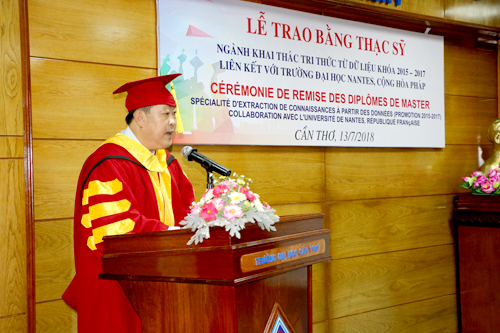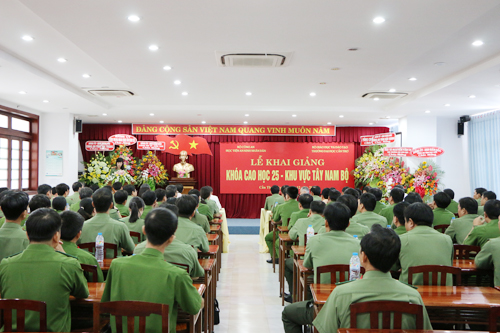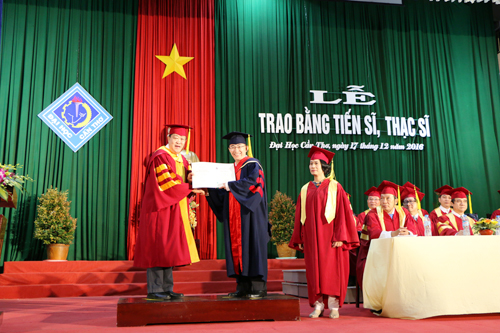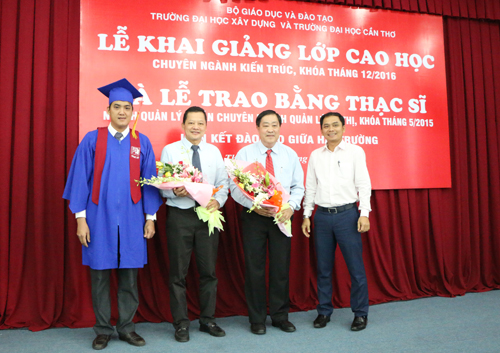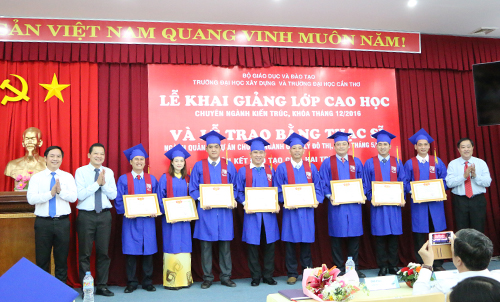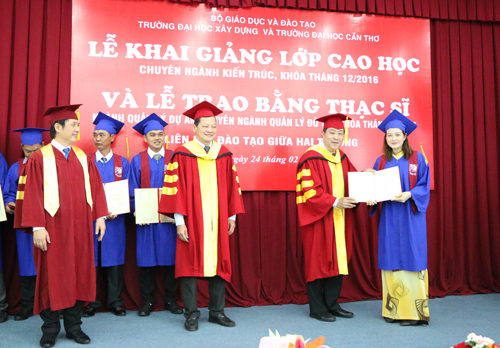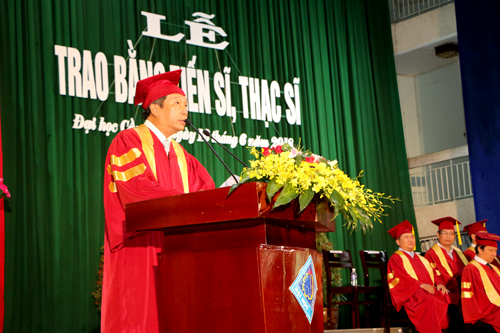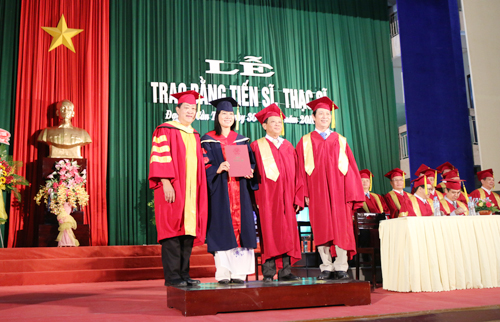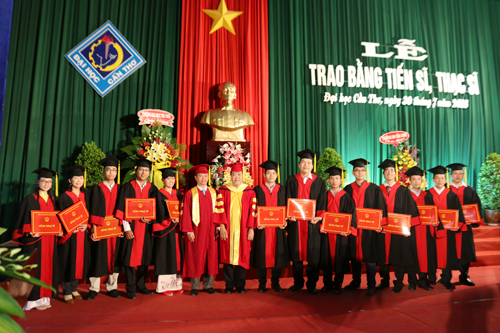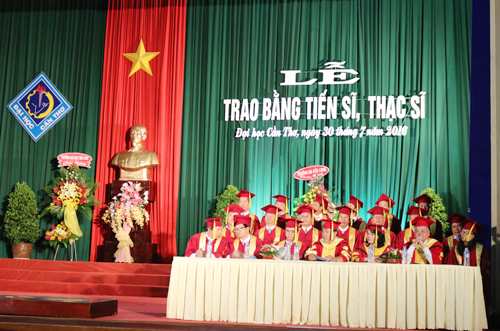Tên đề tài: “Tạo dòng hoa hồng Lửa (Rosa hybrida L.) mới bằng phương pháp xử lý đột biến tia gamma in vitro”.
Tác giả: Lê Nguyễn Lan Thanh, Khóa: 2016
Ngành: Khoa học cây trồng; Mã số: 62620110. Nhóm ngành: Nông, lâm nghiệp và thuỷ sản.
Người hướng dẫn chính: GS.TS. Lê Văn Hòa - Trường Đại học Cần Thơ
- Tóm tắt nội dung luận án
Luận án “Tạo dòng hoa hồng Lửa (Rosa hybrida L.) mới bằng phương pháp xử lý đột biến tia gamma in vitro” được thực hiện nhằm (1) Xác định quy trình nhân giống cho giống hoa hồng Lửa bằng phương pháp nuôi cấy mô và tạo vật liệu in vitro cho việc chiếu xạ gây đột biến bằng tia gamma; (2) Xác định liều chiếu xạ thích hợp tạo đột biến về kích thước và màu sắc hoa đối với mẫu đoạn thân hoa hồng Lửa in vitro thông qua giá trị LD50; (3) Chọn được 1 - 2 dòng hoa hồng Lửa mới có triển vọng khác biệt về hình thái và di truyền so với giống hoa hồng Lửa gốc.
Kết quả nghiên cứu đã xác định được quy trình nhân giống hoa hồng Lửa bằng phương pháp nuôi cấy mô với các bước kỹ thuật chính trong thời gian 6 tháng như sau: sử dụng môi trường MS bổ sung BA 1,0 mg/L để nhân nhanh (60 ngày), sử dụng túi cấy thoáng khí chứa môi trường 1/3 MS (10 ngày) nuôi trong điều kiện đèn LED 4R-1B để tạo cây hoàn chỉnh và thuần dưỡng cây trên giá thể tảo và mụn dừa (1:1) trong 20-25 ngày. Đồng thời, từ quy trình này đã nhân giống và tạo vật liệu in vitro cho việc chiếu xạ gây đột biến và áp dụng quy trình trong việc nhân nhanh dòng hoa hồng mới đột biến tạo ra. Đã xác định được liều gây chết LD50 là 20-25 Gy khi chiếu xạ tia gamma in vitro đoạn thân hoa hồng Lửa và liều 15 Gy tạo được nhiều đột biến đa dạng về hình dạng hoa và màu sắc hoa khác với giống hoa hồng Lửa (Giống gốc). Đã tạo được 02 dòng hoa hồng đột biến thuần mới gồm dòng H1 có màu hồng cam (R52C) và dòng H2 có màu hồng (R54B) khác biệt qua phân tích di truyền ở độ tương đồng về di truyền (0.89) và có tính ổn định. Dòng hoa hồng mới H1 khác biệt về màu sắc lá, hoa so với giống hoa hồng Lửa là đột biến ổn định qua các lần nhân giống nhưng chưa thể hiện đường kính hoa to hơn. Cần tiếp tục đánh giá dòng hoa hồng mới H1 ở giai đoạn tuổi cây lớn hơn để có kết luận chính xác về đường kính hoa thể hiện đúng đặc tính của dòng.
- Những đóng góp mới của đề tài
Luận án xây dựng được quy trình kỹ thuật nhân giống hoa hồng Lửa bằng phương pháp nuôi cấy mô và tạo nguồn vật liệu in vitro cho việc chiếu xạ gây đột biến tia gamma; đồng thời, áp dụng quy trình để nhân nhanh dòng hoa hồng đột biến mới tạo ra.
Xác định được liều chiếu xạ hiệu quả trong việc tạo đột biến về kích thước và màu sắc hoa trên mẫu cấy đoạn thân in vitro của giống hoa hồng Lửa.
Tạo được 01 dòng hoa hồng triển vọng từ giống hoa hồng Lửa truyền thống bằng phương pháp xử lý đột biến tia gamma in vitro.
- Ý nghĩa thực tiễn và khả năng ứng dụng của luận án
Kết quả nghiên cứu của luận án cung cấp cơ sở khoa học về việc ứng dụng phương pháp chọn giống đột biến bằng chiếu xạ tia gamma kết hợp nuôi cấy mô để rút ngắn thời gian và tăng hiệu quả chọn tạo giống hoa hồng mới.
Xác định liều chiếu xạ thích hợp tạo đột biến về màu sắc trên mẫu đoạn thân in vitro của giống hoa hồng Lửa; đồng thời đề xuất được phương pháp chọn tạo giống hoa hồng mới.
Về thực tiễn: Tạo ra dòng hoa hồng Lửa mới là nguồn vật liệu cho công tác chọn tạo giống hoa hồng và bổ sung làm đa dạng cơ cấu giống hoa hồng phục vụ cho sản xuất.
Thesis name: Creating a new clone of ‘Lửa’ rose (Rosa hybrida L.) using in vitro gamma ray mutation
Major: Crop Science Major’s code: 62620110
PhD student name: Le Nguyen Lan Thanh Course 2016
Supervisor: Assoc. Prof. Dr. Le Van Hoa
Working places: Agriculture University, Cantho University
- Dissertation summary
The study "Creating a new clone of ‘Lửa’ rose (Rosa hybrida L.) using in vitro gamma ray mutation" was carried out to (1) Determine the propagation process for the ‘Lửa’ rose variety by tissue culture method and setup for in vitro mutagenic irradiation; (2) Determine the appropriate dose of irradiation to cause mutations in flower size and color for in vitro ‘Lửa’ rose stems through the LD50 value; (3) Select 1 - 2 new rose clones that have different prospects in morphology (larger flower diameter, abundance flower colors) and genetics compared to the ‘Lửa’ rose variety.
The research results have determined the process of propagating ‘Lửa’ roses using the tissue culture method with the following main technical steps over a period of 6 months: using MS medium supplemented with 1.0 mg/L BA to rapid multiplication (60 days), using culture bags containing 1/3 MS medium (10 days) grown under LED 4R-1B light conditions to create complete plants and domesticate plants on algae and coco peat substrates (1:1) in 20-25 days. At the same time, from this process, we propagated and established in vitro stems for mutagenic irradiation and applied in this process of selecting and creating new mutant rose clones. The lethal dose LD50 has been determined to be 20-25 Gy when in vitro gamma ray irradiation of ‘Lửa’ rose stems and the dose of 15 Gy created many diverse mutations in flower shape and color that are different from the ‘Lửa’ rose variety (Original variety). There are 02 new pure mutant rose clones (H1 with orange-pink color R52C and H2 clones with pink color R54B) that differ through genetic analysis in genetic similarity (0.89) and stability. The new H1 rose clone is different in leaf and flower color compared to the ‘Lửa’ rose variety, which is a stable mutation through propagation times but does not yet show a larger flower diameter. It is necessary to continue to evaluate the new H1 rose clone at the older plant age stage to have accurate conclusions about flower diameter that properly represents the characteristics of this clone.
- New contributions of the thesis
The thesis has determined a technical process for propagating ‘Lửa’ rose using tissue culture methods and creating in vitro material sources for gamma ray mutagenic irradiation; At the same time, applied the process to quickly multiply the new created mutant rose clone.
Determined the effective dose of irradiation in creating mutations in flower size and color in in vitro stem explants of the ‘Lửa’ rose variety.
Creating a promising rose clone from the traditional ‘Lửa’ rose variety using the in vitro gamma ray mutation treatment method.
- Practical significance and applicability of the thesis
The research results of the thesis provide a scientific basis for the application of mutation breeding method using gamma ray irradiation combined with tissue culture to shorten the time and increase the efficiency of selecting and creating new rose varieties.
Determining the appropriate dose of irradiation to create color mutations in in vitro stem section samples of the ‘Lửa’ rose variety; At the same time, we propose methods for selecting and creating new rose varieties.
In practice: Create a new clone of ‘Lửa’ rose is a source materials for rose breeding and supplementation to diversify rose varieties for production.
- Xem chi tiết nội dung luận án
- Xem thông tin đăng tải tại Website Bộ giáo dục và Đào tạo. (Nhập tên NCS vào ô tìm kiếm)





